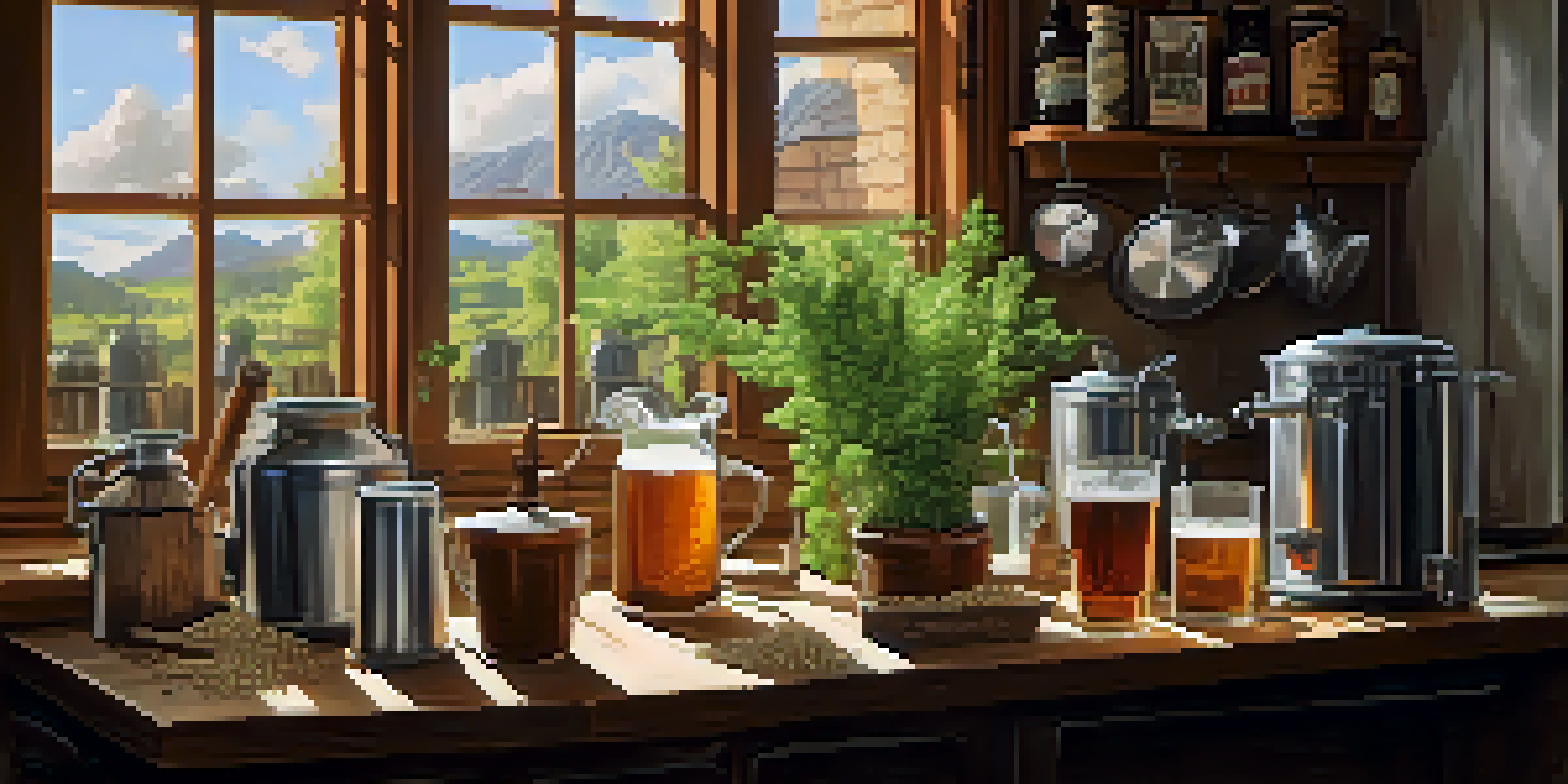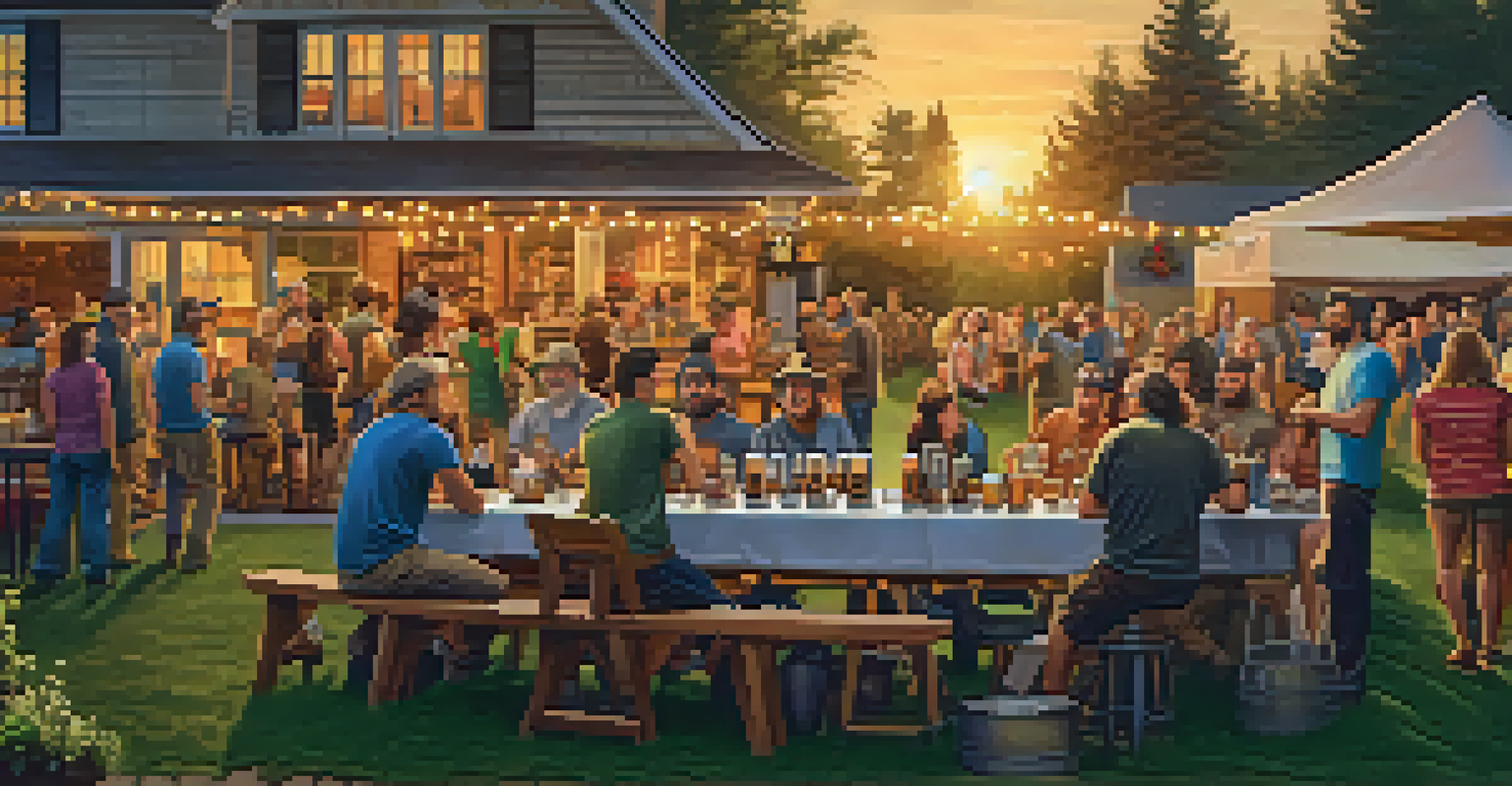The History of Home Brewing: From Ancient Times to Now

Ancient Beginnings: Brewing in Early Civilizations
Home brewing has roots that stretch back to ancient civilizations, where early humans discovered the fermentation process. Archaeological evidence suggests that the Sumerians and Egyptians brewed beer as far back as 5,000 BCE, often using barley and other grains. These early brews were not merely for enjoyment; they played a significant role in religious rituals and daily life, serving as a staple in the diets of these cultures.
Beer is proof that God loves us and wants us to be happy.
In fact, the Sumerians even had a goddess of brewing named Ninkasi, highlighting the significance of beer in their society. This ancient relationship with fermentation paved the way for brewing techniques that would evolve over millennia. As trade routes expanded, the knowledge of brewing spread, influencing various cultures and leading to diverse brewing practices.
Thus, the foundation of home brewing was laid in these ancient societies, where it transformed from a necessity into an art form. This blend of utility and creativity set the stage for the brewing traditions that would emerge in different parts of the world.
Medieval Brewing: Monasteries and Innovations
During the Middle Ages, brewing began to flourish in monasteries across Europe, where monks perfected the craft. They utilized their resources to create richer, more flavorful beers, often using hops, which were discovered to enhance both taste and preservation. This period saw a significant shift from home brewing as a communal activity to a more specialized craft practiced by those dedicated to the art.

Monks not only brewed for their own consumption but also for trade, leading to the establishment of early breweries. They kept detailed records of their brewing processes, allowing for consistency and innovation. This era also marked the introduction of different beer styles, as monks experimented with various ingredients and brewing methods.
Brewing's Ancient Roots
Home brewing dates back to ancient civilizations like the Sumerians and Egyptians, where it played a vital role in daily life and rituals.
As a result, the medieval period significantly impacted the evolution of home brewing, setting standards that would influence future generations. The knowledge gained during this time laid the groundwork for modern brewing practices, combining scientific principles with traditional techniques.
The Rise of Commercial Breweries: 19th Century Changes
The 19th century brought about a revolution in brewing, with the advent of the Industrial Revolution changing everything. The introduction of steam power and advanced machinery allowed for the mass production of beer, leading to the rise of large commercial breweries. This shift not only changed the scale of production but also the way beer was marketed and distributed.
The history of beer is the history of civilization.
As commercial brewers began to dominate the market, home brewing faced challenges. Many home brewers felt the pressure to conform to the new standards and styles that commercial breweries set. However, this period also sparked a renewed interest in traditional brewing methods, as some enthusiasts sought to reclaim the art of home brewing and create unique flavors.
Thus, while the 19th century marked the rise of large-scale production, it also ignited a passion for home brewing that persisted. This duality between commercial and home brewing would continue to shape the landscape of beer culture for decades to come.
Prohibition Era: Challenges and Resilience
The Prohibition era in the United States from 1920 to 1933 posed significant challenges for both commercial and home brewers. With the ban on alcohol, many breweries were forced to close, and those who continued to brew often did so illegally. However, this dark period also sparked a spirit of resilience among home brewers who sought to keep the craft alive.
Despite the legal restrictions, home brewing persisted in secret, with enthusiasts sharing recipes and techniques through word of mouth. This underground movement fostered a community that valued traditional brewing methods and experimentation. The challenges of Prohibition ultimately strengthened the resolve of home brewers, laying the groundwork for a post-Prohibition revival.
Craft Beer Renaissance
The craft beer movement of the 1970s and 1980s revitalized home brewing, leading to a surge in creativity and community among enthusiasts.
When Prohibition was repealed, many home brewers emerged from the shadows, eager to reclaim their passion. This resurgence not only revitalized interest in brewing but also set the stage for the craft beer movement that would follow.
The Craft Beer Movement: A Home Brewer's Renaissance
The 1970s and 1980s marked the beginning of the craft beer movement, a time when home brewing flourished like never before. As beer enthusiasts sought to break free from the monotony of mass-produced beers, more people began experimenting in their own kitchens. This newfound appreciation for unique flavors and styles led to an explosion of home brewing.
Home brewing clubs and competitions sprouted up across the country, creating a sense of camaraderie among enthusiasts. Many home brewers began winning awards for their creations, inspiring others to take up the craft. The passion for brewing became a shared experience, with people exchanging tips, recipes, and stories about their brewing adventures.
This movement not only revived traditional brewing techniques but also encouraged creativity and innovation. The craft beer scene began to flourish, with many home brewers transitioning to commercial operations, further bridging the gap between home and professional brewing.
Modern Home Brewing: Technology and Accessibility
Today, home brewing has become more accessible than ever, thanks to advancements in technology and the availability of brewing kits. With a wealth of online resources, aspiring brewers can easily learn the ins and outs of the craft. From beginner kits to sophisticated equipment, the options available cater to all skill levels and preferences.
Moreover, the rise of social media has fostered a vibrant community of home brewers who share their experiences and discoveries. Online forums, blogs, and social media groups allow enthusiasts to connect, exchange ideas, and showcase their brews. This sense of community has strengthened the culture of home brewing, encouraging even more people to join in the fun.
Modern Innovations in Home Brewing
Today's home brewing is enhanced by technology and a strong community, making it more accessible and encouraging sustainable practices.
As a result, modern home brewing is not just about making beer; it's about creativity, connection, and exploration. Whether experimenting with new flavors or perfecting a tried-and-true recipe, home brewers today find joy in the process and the camaraderie that comes with it.
The Future of Home Brewing: Trends and Innovations
As we look to the future, the home brewing landscape continues to evolve with emerging trends and innovations. One notable trend is the increased interest in sustainable brewing practices, with home brewers exploring ways to minimize waste and use local ingredients. This not only reflects a growing environmental consciousness but also a desire to support local agriculture.
Additionally, the use of technology in brewing is on the rise, with smart brewing systems and apps that help monitor fermentation processes. These advancements make it easier for home brewers to achieve consistent results and experiment with different styles. The integration of technology is bridging the gap between traditional craftsmanship and modern efficiency.

As the community expands, we can expect to see even more diverse flavors and styles emerge from home brewers. The future of home brewing looks bright, with enthusiasts continuously pushing the boundaries of creativity and sustainability. This journey from ancient times to now shows that home brewing is more than just a hobby; it’s a celebration of tradition, innovation, and community.